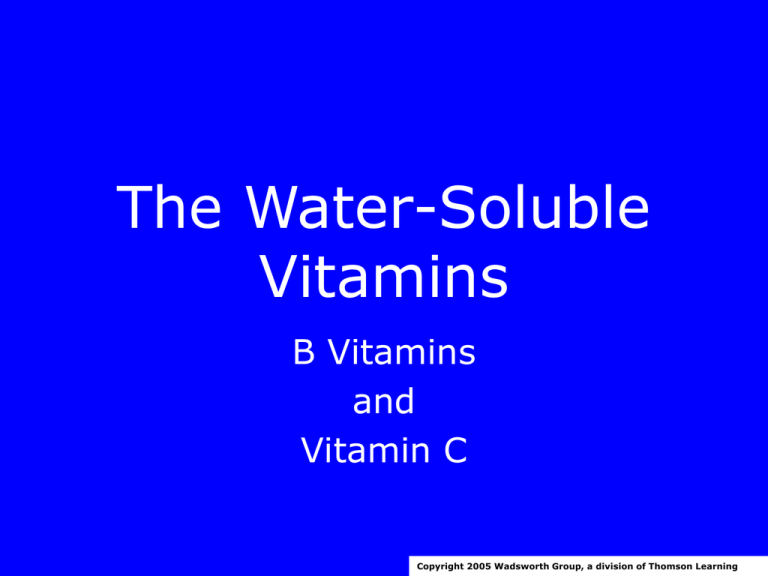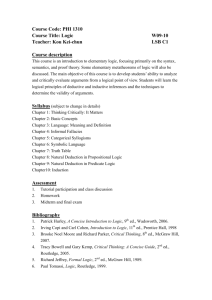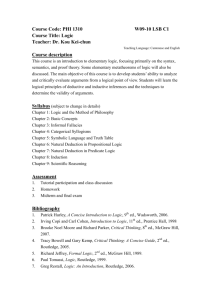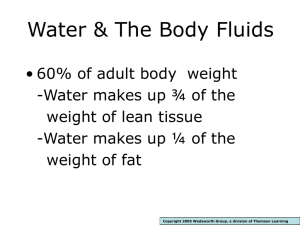Water-sol vit 244
advertisement

The Water-Soluble Vitamins B Vitamins and Vitamin C Copyright 2005 Wadsworth Group, a division of Thomson Learning The Vitamins • Vitamins vs carbohydrates, fats, and proteins –Structure •Individual units –Function •Coenzymes and other –Food contents • mcg or mg Copyright 2005 Wadsworth Group, a division of Thomson Learning The Vitamins • Bioavailability • Precursors • Organic nature Copyright 2005 Wadsworth Group, a division of Thomson Learning The Vitamins • Solubility • Toxicity Copyright 2005 Wadsworth Group, a division of Thomson Learning The Vitamins Copyright 2005 Wadsworth Group, a division of Thomson Learning The Vitamins Copyright 2005 Wadsworth Group, a division of Thomson Learning The B Vitamins • Coenzymes Copyright 2005 Wadsworth Group, a division of Thomson Learning Thiamin • Other names: Vitamin B1 • 1998 RDA – men: 1.2 mg/day – women: 1.1 mg/day • Chief functions in the body – Part of coenzyme TPP (thiamin pyrophosphate) used in energy metabolism Copyright 2005 Wadsworth Group, a division of Thomson Learning Thiamin • Significant sources – Whole grain, fortified, or enriched grain products – Moderate amounts in all nutritious food – Pork • Easily destroyed by heat Copyright 2005 Wadsworth Group, a division of Thomson Learning Thiamin • Deficiency disease – Beriberi • Wet, with edema • Dry, with muscle wasting • Deficiency symptoms – Enlarged heart, cardiac failure – Muscular weakness – Apathy, poor short-term memory, confusion, irritability – Anorexia, weight loss • Toxicity symptoms: none reported Copyright 2005 Wadsworth Group, a division of Thomson Learning Thiamin Sources Copyright 2005 Wadsworth Group, a division of Thomson Learning Copyright 2005 Wadsworth Group, a division of Thomson Learning Riboflavin Copyright 2005 Wadsworth Group, a division of Thomson Learning Riboflavin • Other names: Vitamin B2 • 1998 RDA – Men: 1.3 mg/day – Women: 1.1 mg/day • Chief functions in the body – Part of coenzymes FMN (flavin mononucleotide) and FAD (flavin adenine dinucleotide) used in energy metabolism. Copyright 2005 Wadsworth Group, a division of Thomson Learning Riboflavin • Significant sources – Milk products (yogurt, cheese) – Enriched or whole grains – Liver • Easily destroyed by ultraviolet light and irradiation Copyright 2005 Wadsworth Group, a division of Thomson Learning Riboflavin • Deficiency disease: ariboflavinosis • Deficiency symptoms – Inflamed eyelids and sensitivity to light, reddening of cornea – Sore throat – Cracks and redness at corners of mouth – Painful, smooth, purplish red tongue – Inflammation characterized by skin lesions covered with greasy scales • Toxicity symptoms: none reported Copyright 2005 Wadsworth Group, a division of Thomson Learning Riboflavin Sources Copyright 2005 Wadsworth Group, a division of Thomson Learning Copyright 2005 Wadsworth Group, a division of Thomson Learning Niacin • Other names – Nicotinic acid – Nicotinamide – Niacinamide – Vitamin B3 • Precursor: dietary tryptophan • 1998 RDA – Men: 16 mg NE/day – Women: 14 mg NE/day • Upper level for adults: 35 mg/day Copyright 2005 Wadsworth Group, a division of Thomson Learning Niacin • Chief functions in the body – Part of coenzymes NAD (nicotinamide adenine dinucleotide) and NADP (its phosphate form) used in energy metabolism • Significant sources – Milk, eggs, meat, poultry, fish – Whole-grain and enriched breads and cereals – Nuts – All protein-containing foods Copyright 2005 Wadsworth Group, a division of Thomson Learning Niacin • Deficiency disease: pellagra • Deficiency symptoms – Diarrhea, abdominal pain, vomiting – Inflamed, swollen, smooth, bright red tongue – Depression, apathy, fatigue, loss of memory, headache – Bilateral symmetrical rash on areas exposed to sunlight Copyright 2005 Wadsworth Group, a division of Thomson Learning Niacin • Toxicity symptoms – Painful flush, hives, and rash (“niacin flush”) – Excessive sweating – Blurred vision – Liver damage, impaired glucose tolerance Copyright 2005 Wadsworth Group, a division of Thomson Learning Niacin Sources Copyright 2005 Wadsworth Group, a division of Thomson Learning Copyright 2005 Wadsworth Group, a division of Thomson Learning Biotin • 1998 adequate intake (AI) – Adults: 30 g/day • Chief functions in the body – Part of a coenzyme used in energy metabolism, fat synthesis, amino acid metabolism, and glycogen synthesis • Significant sources – Widespread in foods – Organ meats, egg yolks, soybeans, fish, whole grains – Also produced by GI bacteria Copyright 2005 Wadsworth Group, a division of Thomson Learning Biotin • Deficiency symptoms – Depression, lethargy, hallucinations, numb or tingling sensation in the arms and legs – Red, scaly rash around the eyes, nose, and mouth – Hair loss • Toxicity symptoms: none reported Copyright 2005 Wadsworth Group, a division of Thomson Learning Pantothenic Acid • 1998 adequate intake (AI) – Adults: 5 mg/day • Chief functions in the body – Part of coenzyme A, used in energy metabolism • Significant sources – Widespread in foods – Organ meats, mushrooms, avocados, broccoli, whole grains • Easily destroyed by food processing Copyright 2005 Wadsworth Group, a division of Thomson Learning Pantothenic Acid • Deficiency symptoms – Vomiting, nausea, stomach cramps – Insomnia, fatigue, depression, irritability, restlessness, apathy – Hypoglycemia, increased sensitivity to insulin • Toxicity symptoms: none reported Copyright 2005 Wadsworth Group, a division of Thomson Learning Vitamin B6 • Other names – Pyridoxine – Pyridoxal – Pyridoxamine • 1998 RDA – Adults (19-50 years): 1.3 mg/day • Upper level for adults: 100 mg/day Copyright 2005 Wadsworth Group, a division of Thomson Learning Vitamin B6 • Chief functions in the body – Part of coenzymes PLP (pyridoxal phosphate) and PMP (pyridoxamine phosphate) used in amino acid and fatty acid metabolism – Helps to convert tryptophan to niacin and to serotonin – Helps to make red blood cells Copyright 2005 Wadsworth Group, a division of Thomson Learning Vitamin B6 • Significant sources – Meats, fish, poultry – Potatoes, legumes, noncitrus fruits – Fortified cereals – Liver – Soy products • Deficiency symptoms – Scaly dermatitis – Anemia (small-cell type) – Depression, confusion, abnormal brain wave pattern, convulsions Copyright 2005 Wadsworth Group, a division of Thomson Learning Vitamin B6 • Toxicity symptoms – Depression, fatigue, irritability, headaches – Nerve damage causing numbness and muscle weakness leading to an inability to walk and convulsions – Skin lesions Copyright 2005 Wadsworth Group, a division of Thomson Learning Vitamin B6 Sources Copyright 2005 Wadsworth Group, a division of Thomson Learning Copyright 2005 Wadsworth Group, a division of Thomson Learning Folate Copyright 2005 Wadsworth Group, a division of Thomson Learning Folate Copyright 2005 Wadsworth Group, a division of Thomson Learning Folate • Absorption • Activation –Vitamin B12 Copyright 2005 Wadsworth Group, a division of Thomson Learning Folate • Recommendations –Dietary folate equivalents (DFE) •Natural = 1X •Synthetic = 1.7 X natural because it is more bioavailable Copyright 2005 Wadsworth Group, a division of Thomson Learning Folate • Neural tube defects –Spina bifida Jan 1998 Copyright 2005 Wadsworth Group, a division of Thomson Learning Folate • Heart disease • Cancer Copyright 2005 Wadsworth Group, a division of Thomson Learning Folate: In Summary • Other names – Folic acid – Folacin – Pteroylglutamic acid (PGA) • 1998 RDA – Adults: 400 g/day • Upper level for adults: 1000 g/day Copyright 2005 Wadsworth Group, a division of Thomson Learning Folate: In Summary • Chief functions in the body – Part of coenzymes THF (tetrahydrofolate) and DHF (dihydrofolate) used in DNA synthesis and therefore important in new cell formation • Significant sources – Fortified grains – Leafy green vegetables, legumes, seeds – Liver Copyright 2005 Wadsworth Group, a division of Thomson Learning Folate: In Summary • Deficiency symptoms – Anemia (large-cell type) – Smooth, red tongue – Mental confusion, weakness, fatigue, irritability, headache • Toxicity symptoms – Masks vitamin B12-deficiency symptoms Copyright 2005 Wadsworth Group, a division of Thomson Learning Folate Sources Copyright 2005 Wadsworth Group, a division of Thomson Learning Vitamin B12 • Activation –Folate Copyright 2005 Wadsworth Group, a division of Thomson Learning Vitamin B12 • Absorption –HCl –Pepsin –Intrinsic factor Copyright 2005 Wadsworth Group, a division of Thomson Learning Vitamin B12 • Deficiency of folate or B12 produces pernicious anemia Copyright 2005 Wadsworth Group, a division of Thomson Learning Vitamin B12: In Summary • Other names: cobalamin (and related forms) • 1998 RDA – Adults: 2.4 g/day • Chief functions in the body – Part of coenzymes methylcobalamin and deoxyadenosylcobalamin used in new cell synthesis – Helps to maintain nerve cells – Reforms folate coenzyme – Helps to break down some fatty acids and amino acids Copyright 2005 Wadsworth Group, a division of Thomson Learning Vitamin B12: In Summary • Significant sources – Animal products (meat, fish, poultry, shellfish, milk, cheese, eggs) – Fortified cereals • Easily destroyed by microwave cooking • Deficiency disease: pernicious anemia Copyright 2005 Wadsworth Group, a division of Thomson Learning Vitamin B12: In Summary • Deficiency symptoms – Anemia (large-cell type) – Fatigue, degeneration of peripheral nerves progressing to paralysis • Toxicity symptoms: none reported Copyright 2005 Wadsworth Group, a division of Thomson Learning Non-B Vitamins • Choline Copyright 2005 Wadsworth Group, a division of Thomson Learning Non-B Vitamins • Inositol • Carnitine • Vitamin imposters Copyright 2005 Wadsworth Group, a division of Thomson Learning Copyright 2005 Wadsworth Group, a division of Thomson Learning Metabolic Pathways Involving B Vitamins The B Vitamins • B vitamin deficiencies –Glossitis –Cheilosis • B vitamin toxicities • B vitamin food sources Copyright 2005 Wadsworth Group, a division of Thomson Learning Vitamin C Copyright 2005 Wadsworth Group, a division of Thomson Learning Vitamin C • Other name: ascorbic acid • 2000 RDA – Men: 90 mg/day – Women: 75 mg/day – Smokers: + 35 mg/day • Upper level for adults: 2000 mg/day Copyright 2005 Wadsworth Group, a division of Thomson Learning Vitamin C • Chief functions in the body – Collagen synthesis • Strengthens blood vessel walls, forms scar tissue, provides matrix for bone growth – Antioxidant – Thyroxin synthesis – Amino acid metabolism – Strengthens resistance to infection – Helps in absorption of iron Copyright 2005 Wadsworth Group, a division of Thomson Learning Vitamin C • Significant sources – Citrus fruits – Cabbage-type vegetables, dark green vegetables (such as bell peppers and broccoli) – Cantaloupe, strawberries – Lettuce, tomatoes, potatoes – Papayas, mangoes • Easily destroyed by heat and oxygen Copyright 2005 Wadsworth Group, a division of Thomson Learning Vitamin C • Deficiency disease: scurvy • Deficiency symptoms – Anemia (small-cell type) – Atherosclerotic plaques – Pinpoint hemorrhages, bone fragility, joint pain – Poor wound healing, frequent infections, bleeding gums, loosened teeth – Muscle degeneration and pain, hysteria, depression, rough skin, blotchy bruises Copyright 2005 Wadsworth Group, a division of Thomson Learning Vitamin C • Deficiency disease: scurvy • Deficiency symptoms – the four Hs – Hemorrhage • Bleeding – Hyperkeratosis • Flaky skin; poor wound healing – Hematologic • Anemia (fatigue) – Hypochondriasis • Depression, anxiety, hysteria Vitamin C • Toxicity symptoms – Nausea, abdominal cramps, diarrhea – Headache, fatigue, insomnia – Hot flashes, rashes – Interference with medical tests, aggravation of gout symptoms, urinary tract problems, kidney stones Copyright 2005 Wadsworth Group, a division of Thomson Learning Vitamin C Sources 5 servings of fruits and vegetables provides about 210 mg Copyright 2005 Wadsworth Group, a division of Thomson Learning Copyright 2005 Wadsworth Group, a division of Thomson Learning Vitamin And Mineral Supplements • Arguments for supplements –Correct overt deficiencies –Improve nutrition status –Reduce disease risks –Support increased nutrient needs –Improve the body’s defenses Copyright 2005 Wadsworth Group, a division of Thomson Learning Vitamin And Mineral Supplements • Who needs supplements? Copyright 2005 Wadsworth Group, a division of Thomson Learning Vitamin And Mineral Supplements • Arguments against supplements –Toxicity –Life-threatening misinformation –Unknown needs –False sense of security –Other invalid reasons Copyright 2005 Wadsworth Group, a division of Thomson Learning Vitamin And Mineral Supplements • Bioavailability • Antagonistic actions Copyright 2005 Wadsworth Group, a division of Thomson Learning Vitamin And Mineral Supplements • Selection of supplements –Form –Contents –Misleading claims –Cost Copyright 2005 Wadsworth Group, a division of Thomson Learning Vitamin And Mineral Supplements • Regulation of supplements Copyright 2005 Wadsworth Group, a division of Thomson Learning An Example of a Supplement Label Copyright 2005 Wadsworth Group, a division of Thomson Learning






